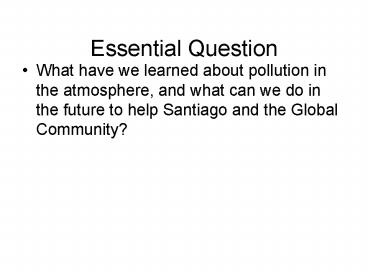Essential Question - PowerPoint PPT Presentation
1 / 26
Title:
Essential Question
Description:
Use today's time wisely- that's the expectation. Decide who ... E. Who should be responsible for the burden of preventing or improving the smog in Santiago? ... – PowerPoint PPT presentation
Number of Views:81
Avg rating:3.0/5.0
Title: Essential Question
1
Essential Question
- What have we learned about pollution in the
atmosphere, and what can we do in the future to
help Santiago and the Global Community?
2
The Black Smog! (photochemical)
3
Thermal (Temperature) Inversion
4
Thermal (Temperature) Inversion
- Lets look at a model.
5
The Main Culprits of smog..
6
The Main Culprits of smog ..
- Nitrogen oxides
- Volatile Organic Compounds (Hydrocarbons)
- Tropospheric Ozone
- Particulate Matter
7
The Main Culprits of smog ..
- Nitrogen oxides
- Volatile Organic Compounds (Hydrocarbons)
- Tropospheric Ozone
- Particulate Matter
- SUN!!!
8
The Main Culprits of smog ..
- Nitrogen oxides
- Volatile Organic Compounds (Hydrocarbons)
- Tropospheric Ozone
- Particulate Matter
- SUN!!!
- A THERMAL INVERSION doesnt make things any
better.
9
UV light
10
Composition of atmosphere
11
Composition of atmosphere
- 78 nitrogen
- 21 oxygen
- Less than 1 carbon dioxide, water, hydrogen,
ozone
12
Formation of nitrogen monoxide
- From combustion of nitrogen gas
13
Formation of nitrogen dioxide from nitrogen
monoxide
14
Primary Pollutants (directly emitted)
15
Primary Pollutants (directly emitted)
- Nitrogen monoxide
- Particulates
- HCs (VOCs) (Remember INCOMPLETE combustion??????
16
Secondary Pollutants (from chemical or
photochemical reactions of primary pollutants)
17
Secondary Pollutants (from chemical or
photochemical reactions of primary pollutants)
- Tropospheric Ozone
- PAN (peroxyacetal nitrate)
18
3-Way Catalytic Converters
19
3-Way Catalytic Converters
- 1. Break down Nitrogen Oxides
20
3-Way Catalytic Converters
- 1. Break down Nitrogen Oxides
- 2. Completely combust Carbon Monoxide
21
3-Way Catalytic Converters
- 1. Break down Nitrogen Oxides
- 2. Completely combust Carbon Monoxide
- 3. Completely combust HCs
22
(No Transcript)
23
The Black Smog!
24
Your assignment, should you choose (or should you
not choose) to accept.
25
Your assignment, should you choose (or should you
not choose) to accept.
- Get in your group, and rank your preferences in
order. - Use todays time wisely- thats the expectation.
- Decide who will do what
- Give your ppt presentation in 2 classes
26
A. Recall that the causes of photochemical smog
are nitrogen oxides from combustion,
hydrocarbons, sunlight, and dust all reacting to
produce ozone and other oxidizing chemicals.
Where, specifically, does the air pollution come
from in Santiago, Chile? What sorts of chemicals
are in our air? Have there been studies on this
subject? Give examples. B. Describe the
formation and consequences of a temperature
inversion. Consider Santiago, Chile as an
example. Other cities in the world may be used
as well. Use diagrams. Has there been research
done that suggests possible ways to remove a
thermal inversion from a certain area? C.
Outline the harmful effects of photochemical
smog. Find out what is happening to people in
Santiago, Chile from smog. What does the
government do to protect people from smog? How
do they treat victims of damage from smog? How
many Santiaguinos are affected by smog, annually?
Have affected citizens tried to get involved in
solutions to the problem? D. Discuss the ways
to reduce smog. Examples might be Catalytic
Converters, mass transit, clean fuels, reducing
dust, and anything else. How does Santiago reduce
air pollution? Who enforces the rules? Who
should enforce the rules? E. Who should be
responsible for the burden of preventing or
improving the smog in Santiago? Which
organizations should have to pay for the damage
due to the smog? Whos responsibility is it to
take charge of the problem? Back your answers up
with thoughtful research on the subject. F. How
does Santiagos air rate with other cities in the
world? What is the percentage of days that are
considered to be harmful to human health? How
does this compare with other large cities?































